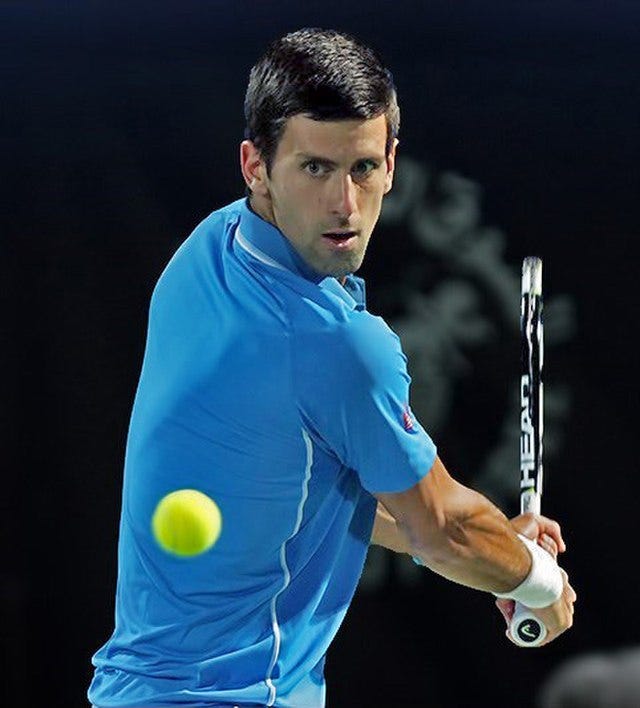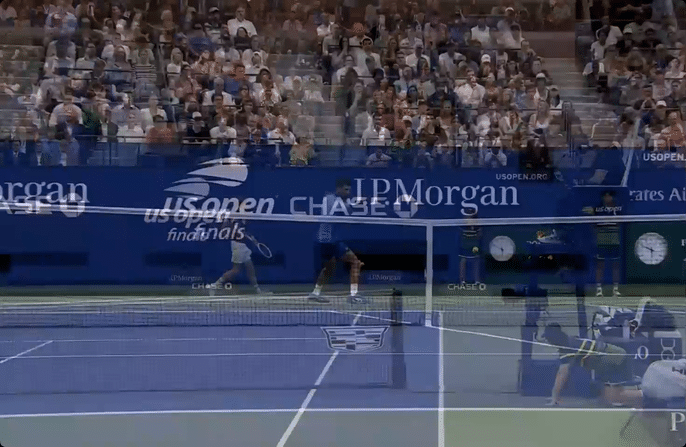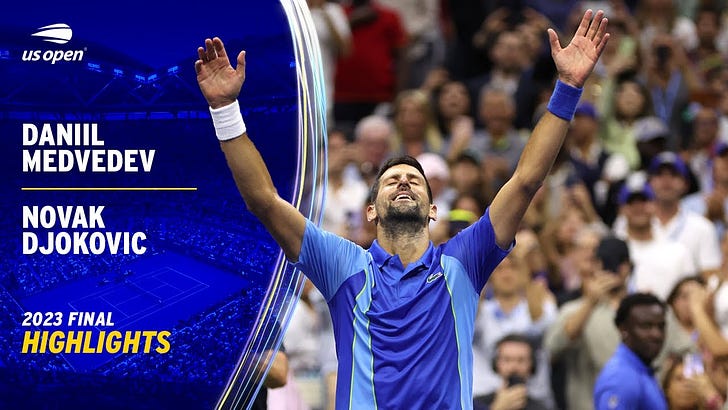Novak Djokovic defeated Daniil Medvedev in the final of the US Open 6/3 7/6 6/3 to clinch his 24th Grand Slam singles title and extend his H2H over Medvedev to 10-5. The Serb has now won three of the calendar year’s four slams for a record fourth time:

In my semifinals recap, I touched on two key areas in the Djokovic/Medvedev rivalry:
First serve
Forecourt ability: slice/drop shots/volleys etc.
Because both are natural counterpunchers, the rallies tend to extend when the free points on serve dry up. As both defend so well with their stock groundstroke games, their ability to execute short slices, drop shots, and sneak volleys has often played a crucial role in unsettling the other. Djokovic has come out on top recently in such matches, winning four of the last five. However, with Medvedev’s newfound confidence in his forehand and improved ability to dictate with that wing, we might see the Russian surprise us once again.
If one had been unfamiliar with Djokovic vs. Medvedev matches coming into today’s final, the first point did well to get you up to speed:
Whilst both men took out a power-hitting opponent in their respective semifinals, this control vs. control affair always makes for cagey rallies full of butterfly-patterned directional changes that simmer, for what seems like minutes, before one player inevitably blinks—either tactically with a bailed-out drop shot, or physically with a legless slap—and then they go back to their towels, readying themselves for it all over again. It’s kind of Sisyphean.
Or at least it used to be. From the Wimbledon final analysis:
What Djokovic now lacks in youthful energy, he makes up for with experience. This version of Djokovic, at 36 years of age and
2324* major titles, isn’t the fastest, fittest, or most consistent version we have seen, but he is the most complete. The serve is more precise, and elements of his game that were awkward and rough-edged in his youth have now been polished in the competitive grit of the tour.
The edges of the game—what I sometimes call “intangibles”—have provided Djokovic with new avenues of victory. The backhand slice is a reliable changeup, and the drop shot—especially from the backhand wing—is still a silent killer, but the biggest improvement over the last decade has been his willingness and excellence in the forecourt, where he is able to absorb and feather volleys, often in the biggest moments. Against Medvedev’s outrageous return position, it was always going to play a pivotal role in this match. It didn’t take long for Djokovic to target the Russian’s Achilles heel:
But might I rewind a game now and showcase perfectly why this guy is such a giant of the game?
Look at the depth of each ball. Now notice that he can do that while changing the direction: line and cross. Now notice he can do all that while running side-to-side. The pressure is relentless, and I contend that it’s largely possible due to his flawless technique. As I have said before “technique dictates tactic”.

Robbie Koenig: “I remember when he [Djokovic] really burst on the scene big time in Canada–he beat the top three players in the world to win in 2007—his linear shots, his ability to change from the crosscourt to the down the line, is what stood out above anything else in his game”
Federer. Nadal. Djokovic. Serena. These modern-day 20-slammers all have similar fundamentals in their strokes when at the peak of their powers. High and full take-backs.
And it’s this reduction in lag, this reduction in wrist action, and reduction in racquet speed—by virtue of a (relatively) heavier frame— on both his forehand and backhand wings, that I believe has allowed Djokovic to dominate the game to unchartered degrees. There’s none of the outside setup or “dynamic flip” going on in his game that has been somewhat encouraged in some circles.

It must be said that Daniil Medvedev deserves an honourable mention in all this “lag reduction” chat. Despite all the labels of his technique being “funky” or “weird”, he’s simple where it counts around contact. Last year—when the Russian was struggling by his standards—I wrote a piece on Sinner and Alcaraz that touched on control. An excerpt:
“Of all the youngsters coming through, it has never been an issue of spin and power. Many people talk of a shot having a higher “margin of safety” (height over the net) because it has more spin, but fail to recognise that it has usually come at the expense of a noisier swing; the swing has less margin for error in timing the ball. Medvedev has very little spin on his groundstrokes, but is extremely consistent because his strokes have high margins technically. These are nit-picky one-percenters, but one percent at this level is a huge difference.”
But back to the keys of the match: the serve and the intangibles. Through the first the Serb was dominating both, winning 6/7 “intangible points” (where the player used a drop shot, short slice, volley, or lob) to Medvedev’s 1/2. The Russian’s serve had started poorly, and the early break was all Djokovic needed as he held to a 6-3 first-set win.
Medvedev was barely holding on through the early stages of the second set. All his service games were going to deuce as Djokovic breezed through a couple of 40/0 games on his own serve.
When Medvedev got his teeth into rallies he seemed torn between trying to slowball Djokovic through the middle and make the Serb take on risk, or take on more risk himself and get Djokovic moving and tired. Serving at 2-3 the stats weren’t pretty:
The seventh game of the second set featured exhausting rallies that had Djokovic on his back gasping for air. Coupled with the nerves that present themselves on important points, I can’t imagine just how tiresome some of these 30-shot rallies were. I counted one rally lasting 54(!) seconds. It seemed that following every lung-busting effort, Djokovic would give in to his legs and take on more aggression. But he gets away with it better than most. This backhand winner crosscourt was hit the point after a 32-shot rally.

Koenig: “He [Djokovic] has a few more options than Medvedev. His strikes tend to be a bit straighter.”
Medvedev would hold that game, but Koenig was right; Djokovic just has more options. He can tap into more topspin and more power, he moves better, he serves better, and he dominates the intangibles. He’s just a colossal player to overcome.
Medvedev would actually generate a breakpoint in the very next game. The momentum was ever so slightly shifting, painfully slowly if you were a Medvedev fan, like some carnival cruise ship slowly floating around its lone anchor point in a lazy wind. But just when you felt the Russian had hit the ball that would earn him a break, the Serb’s intangibles showcased themselves once more:
Both players would hold to a tie-break, but by this stage you felt that it was Medvedev who would feel cheated if he lost it. Of the two players, he was the one who had produced genuine chances, but Djokovic had found it in the big moments—those inches and split-second decisions and reactions that are made on instincts—to stay alive in the set. Djokovic would read it correctly, of course
Medvedev took the early lead in the tiebreaker 3-1, and again you felt that he had wrestled the momentum into his bag over an excruciatingly long set. At 4-4, Medvedev found a few forehands that forced Djokovic to slide defensively and slice off both wings. It was painfully obvious how little stopping power there is in Medvedev’s strokes, but he managed to win a rare cat-and-mouse finish after tracking down a Djokovic drop shot and giving it back just as short. You could see the fatigue in Djokovic’s body language. It had also seeped into his stat sheet:
And Medvedev was clearly the stronger player as things got more brutal:
And yet Djokovic did it again. He went into lockdown mode when he needed it. At 4-5 he set about hitting his backhand crosscourt for an hour, but Medvedev cracked in under a minute. At 5-5 he produced another wide first serve and followed it in. Medvedev’s forehand missed by several metres wide. And then on Djokovic’s first set point, Medvedev’s backhand cracked. Simple as that.
After 104 minutes of toil, Medvedev was down two sets to love.
The third set was the easiest and quickest. Djokovic, like all great players, is a formidable frontrunner. To make matters worse, Medvedev was clearly still thinking about the second set and had little else to bring to the table. There’s no plan b with the Russian. He is a counterpuncher so he counterpunches. That stubbornness is a double-edged sword.
Interestingly, very late in the piece, with Djokovic serving for the match at 5-3, Medvedev actually stepped in on a serve and took the return early. Where was that two sets ago??
By my count I had Djokovic winning 27/39 intangible points. I had Medvedev winning 4/8. That right there shows you just how custom-made and rigid the Russian’s game is. You can see below how wildly successful the Serb’s serve and volley play was, and I don’t have any stats for it but I bet Djokovic’s unreturned serves—a metric I prefer over aces—would be quite handsome also.
And so now he sits at 24.
Goran tells us he plans on playing in the Los Angeles Olympics in 2028! With his dedication to his diet, fitness, and willingness to improve, I don’t think he’ll be going there to just make up the numbers.
Who’s going to stop him?










Always felt unlikely Medvedev could back up that semi final performance. His passing choices were perfect in that game and fairly poor in this, although credit to Djokovic for his instinct.
Djokovic is still clearly one of the fittest on tour. But I don't think hes the fittest, and he's perceptilbily beginning to fade over the last couple of years. Of course he's adapted with a slightly more aggressive gamestyle. But he's now massively helped by next gens poor techniques, and lack of ability to stay in tough rallies when it matters, extend points and really test his stamina. I'd only trust Medvedev and probably Rune to match him when they go locking down, Alcaraz can but his forehand sprays too often.
Great analysis again!! I always felt that being outside the 6-6'3" range is tough. Medvedev gives up too much at his height. A "shorter" player will always be more agile. It's like Sugar Ray Leonard or the great Ali. They were fast and agile. Djokovic is starting to look like a classic player now. He can punch and counterpunch. That makes him so much more dangerous.
I think he is managing extremely well physically. I just don't know if 2028 is reasonable. Everyone thought Roger might play to 41, Tom Brady until he is 50 and now Djokovic until 41. I think he has a few more left in him but it will be tough for him to win 7 matches against younger foes.
The part you hit on the head is the need to clean up the strokes. Everyone is enamored with the huge spin and speed potential of the game. It was Robert Lansdorp whose philosophy was that tennis is about hitting a skidding ball near the line. He criticized Sampras for reversing his finishes. Then he realized that Sampras was solving a problem. Sampras's forehand is, as you noted, a stylized version of Lendl's. Classic and clean.
You are telling us that what is old is new. And he we are with Djokovic who has become a complete player. Alcaraz, too!
Again, thanks for the great analysis.
One question, Do you think it is Medvedev's lack of down the line backhands that hurt him? He just seems much less comfortable going down the line especially with low backhands.
I think the only one that I have seen dominate Djokovic in this regard is Wawrinka. He could hit down the line backhand and short cross court backhands at will. Even off of low balls, Wawrinka could make Djokovic pay.
Wawrinka won't be playing in 2028. But his backhand, in my eyes, was the only one that could stand up to the modern two hander and come out on top.
It might be time for all the one handers to clean up their strokes, too!